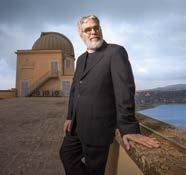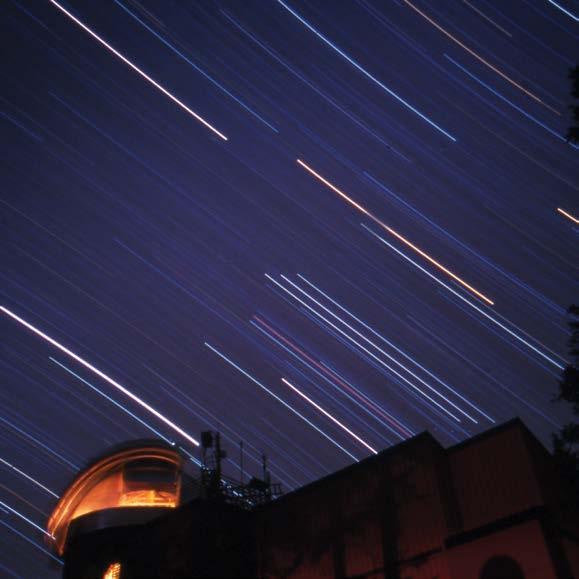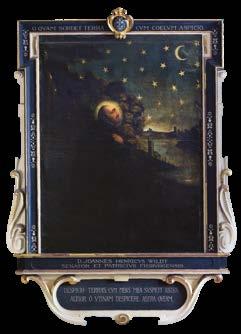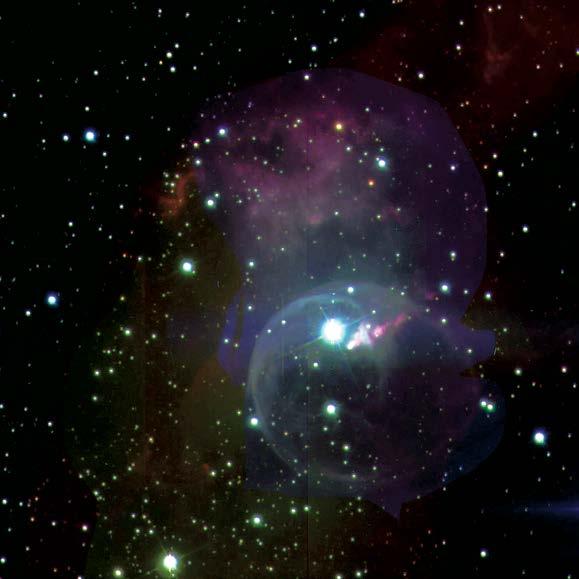A JESUIT’S GUIDE TO THE

Exploring Wonder, Beauty, and Science


Guy Consolmagno, SJ




Guy Consolmagno, SJ

Guy Consolmagno, SJ
Copyright © 2025 Guy Consolmagno, SJ
All rights reserved.
For a comprehensive listing of editorial permissions, please refer to page 213. The acknowledgments for all artwork can be found on pages 215–216.
To purchase copies of this book in bulk, please contact our Customer Service team at (800) 621-1008.
ISBN: 978-0-8294-5573-1
Library of Congress Control Number: 2024939106
Published in Chicago, IL Printed in China
To the memory of Fr. Martin McCarthy, SJ (1923–2010), who showed me the joy of being a Jesuit astronomer.



This book is about Jesuits and stars. Lots of Jesuits—from historical figures to me, the author. Lots of stars—clusters and galaxies of stars. And around them, planets and asteroids and meteorites as well.
Too often we fail to realize our remarkable place in the universe. We get bogged down by personal crises and the problems of the world. Sometimes we fear that we must abandon either our religion or our science as we try to find our way out of despair. We let our curiosity about the universe go stale. Those of us with a scientific bent, like doctors and engineers, can lose sight of how our science is rooted in religion and its search for truth and beauty. Some people think that science and religion are at war.
This book shows how each illuminates the other.
All my life I have loved to look at the stars. But even more, I love how the stars themselves remind me of a universe so much larger than my own mundane concerns. I love how my knowledge of those stars reminds me of my own personal history, as well as my culture’s history and my religion’s history of pondering those stars. And I love how the beauty in the sky is but an invitation to the surprising beauty found in astronomy itself, in science, in how we come to understand what we see.
The stars are beautiful. It is a joy to contemplate them. They can be a place to find God. Finding God in the stars is a quest dating back to the Psalms and Scripture, and it is something that anyone can do even today. But it just might be helpful to have a guide to show the way.
Brother Guy Vatican Observatory


In The Autobiography of St. Ignatius, which Ignatius dictated to a scribe who recorded it in the third person, we read, “The greatest consolation he received was to look at the sky and the stars, which he often did and for a long time . . .” St. Ignatius of Loyola (1491–1556) was the founder of the Society of Jesus, commonly known as the Jesuits. His first companions, the first Jesuits, were a group of men who met at the University of Paris in the mid-sixteenth century. They developed a unity of hearts and minds from being students together; scholarship was an essential part of what formed them as a Society. Their scholarship, from the beginning, was at the highest academic level, and it included expertise in all the subjects of the university—not only theology and philosophy but also the subjects of the medieval quadrivium: mathematics, music, geometry, and astronomy.
As its name indicates, the Society of Jesus is centered on the person of Jesus. To Christians, Jesus is God’s incarnation within our physical universe, and so it follows that the spirituality of the Society of Jesus is incarnational. What does that mean? Consider the famous Jesuit mantra, “to find God in all things.” Note the emphasis on things: the created world. In that phrase, being close to the created world is taken to be a way of being close to the Creator. This incarnational spirituality is rooted in what we experience when we immerse our minds and our hearts into the study of the universe, when, like St. Ignatius, we spend time looking at the stars.
Throughout their history, Jesuits have had a special connection both to the beauty of the stars and to the study of astronomy. From the first modern map of the Moon (where two dozen craters were named for Jesuits—by the Jesuit who drew the map!)
to the latest understanding of the Big Bang, Jesuits have been found at the frontiers of astronomy. They have also been at the forefront of educating students and scientists about the wonder of the universe.
A Jesuit’s Guide to the Stars is my way, as a Jesuit and an astronomer, of introducing a wider audience to the nighttime sky. It includes stories about the people who have opened up our understanding of the universe, connections between Ignatian spirituality and astronomy, and activities that can help make that universe feel as familiar to you as your own backyard—because it is your backyard!
Most people experience astronomy simply by looking at the stars, or at least by looking at images of things in space as our telescopes and our spacecraft see them. Thus, large parts of this book are photo essays, beginning with Scripture itself. In keeping with the book’s Jesuit theme, virtually all the astronomical images were made by Jesuits or astronomers associated with the Jesuits at the Vatican Observatory, using our various telescopes. (The exceptions are those images that come from spacecraft; the Vatican doesn’t have its own space program—yet!) A number of sky images (I took those) are included as well; after all, the sky itself was also an inspiration to St. Ignatius.
And this is also but one Jesuit’s guide: mine. Woven through these photo essays is my personal story. A lot of it is my take on what the universe looks like to me . . . as an astronomer, as a Jesuit, and as a kid from Detroit who somehow wound up at one time or another on every continent on Earth, pursuing the knowledge of what’s above Earth and how it affects us all down here.
My own formation as a Jesuit began with the Spiritual Exercises. My life as a Jesuit gave me the chance to pursue my passion both as a stargazer and as a meteorite scientist. My studies with the Jesuits introduced me to philosophy, history, and poetry, and they gave me the chance to live and work with astronomers who ponder the very

questions of who we are and where we come from. And my work at the Vatican has made me intimately familiar with the vision of that wonderful fellow Jesuit, Pope Francis, and how his encyclical Laudato si´ defines our place in this universe.
The Moon belongs to everyone. We all live under the same sky. But encountering this universe with the mindset of a Jesuit means going beyond just looking up and thinking, Oh, wow, look at the Moon. It is experiencing everything in a unity of hearts and minds.
Engaging the universe with the heart means not only appreciating its beauty, but also recognizing the love that lies behind that beauty and feeling the joy that is the sure sign of the presence of God in his creation. Engaging the universe with the mind means not only puzzling out its scientific mysteries but also remembering the rich human history behind how we understand the sky . . . and our own personal histories, as well.
A Jesuit’s eye on the sky means beholding it with both nostalgia and amazement, familiarity and mystery, awe and joy—in everything. That’s why they call it the Universe. It is the “all things” where we find God.

People often ask me if the stars are found in the Bible. Of course they are! What is fascinating to me is how the Bible talks about stars, and how they are used as pointers to the One who made them. I don’t pretend that what follows is a complete inventory of stars in Scripture, but it certainly is a representative sampling.
One way to look at the bright things in the sky is to see them the way that all ancient peoples used the stars, as timekeepers. Following the stars’ rhythms is useful if you want to know when to plant or reap, when to expect high tides or bright moonlit nights, how to keep track of the year and the years:
The sun, when it appears, proclaims as it rises what a marvelous instrument it is, the work of the Most High. . . .
Great is the Lord who made it; at his orders it hurries on its course.
It is the moon that marks the changing seasons, governing the times, an everlasting sign.
From the moon comes the sign for festal days, a light that wanes when it completes its course.
The new moon, as its name suggests, renews itself; how marvelous it is in this change, a beacon to the hosts on high, shining in the vault of the heavens!
The glory of the stars is the beauty of heaven, a glittering array in the heights of the Lord.
On the orders of the Holy One they stand in their appointed places; they never relax in their watches.
Sirach 43:2, 5–10


But the stars are more than just utilitarian timekeepers. Stars are also signs of God’s omnipotence, infinity, and everlasting love for his people:
O give thanks to the LORD, for he is good, for his steadfast love endures forever; . . .
who alone does great wonders, for his steadfast love endures forever; who by understanding made the heavens, for his steadfast love endures forever; who spread out the earth on the waters, for his steadfast love endures forever; who made the great lights, for his steadfast love endures forever; the sun to rule over the day, for his steadfast love endures forever; the moon and stars to rule over the night, for his steadfast love endures forever.
Psalm 136:2, 4–9
Indeed, in Scripture we hear about the stars themselves giving praise and adoration!
Then the LORD answered Job out of the whirlwind: . . .
“Where were you when I laid the foundation of the earth?
Tell me, if you have understanding. Who determined its measurements—surely you know! Or who stretched the line upon it?
On what were its bases sunk, or who laid its cornerstone when the morning stars sang together and all the heavenly beings shouted for joy?”
Job 38:1, 4–7
And again:
O Israel, how great is the house of God, how vast the territory that he possesses! It is great and has no bounds; it is high and immeasurable . . .
the one who sends forth the light, and it goes; he called it, and it obeyed him, trembling; the stars shone in their watches, and were glad; he called them, and they said, “Here we are!”
They shone with gladness for him who made them.
This is our God; no other can be compared to him.
Baruch 3:24–25, 33–35


The Bubble Nebula, NGC 7635, imaged at the Vatican Advanced Technology Telescope. The “bubble” is formed by the hot wind emitted from a star inside a cloud of gas and dust located about 10,000 light years away.
Stars tell us about the nature of God, who created them. He loves beauty and elegance. He cares for them, naming them and calling them by name:
He determines the number of the stars; he gives to all of them their names.
Great is our Lord, and abundant in power; his understanding is beyond measure.
Psalm 147:4–5
And that is because God is bigger than any of them and all of them. Stars are God’s creation, designed for delight and beauty, not objects to be worshiped, as the neighbors of Israel were tempted to do:
God made the two great lights—the greater light to rule the day and the lesser light to rule the night—and the stars. God set them in the dome of the sky to give light upon the earth, to rule over the day and over the night, and to separate the light from the darkness. And God saw that it was good. And there was evening and there was morning, the fourth day.
Genesis 1:16–19

In the Genesis teaching, God begins by creating light, so that nothing he does is hidden, nothing is in darkness, nothing is removed from our sight. To quote a bad sci-fi movie trope, there are not “things man was not meant to know!” But as Pope Benedict pointed out in his homily on Holy Saturday, April 7, 2012: “The sun and the moon are created only on the fourth day. The creation account calls them lights, set by God in the firmament of heaven. In this way [the author of Genesis] deliberately takes away the divine character that the great [pagan] religions had assigned to them. No, they are not gods. They are shining bodies created by the one God. But they are preceded by the light through which God’s glory is reflected in the essence of the created being.”
And when you look up to the heavens and see the sun, the moon, and the stars, all the host of heaven, do not be led astray and bow down to them and serve them, things that the LORD your God has allotted to all the peoples everywhere under heaven.
Deuteronomy 4:19